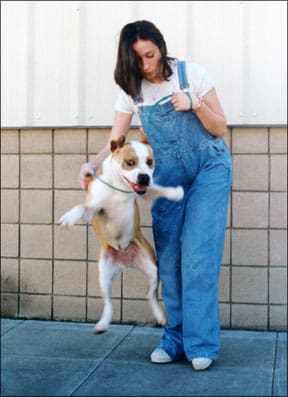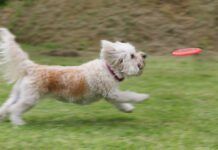These are too-common refrains of guardians of dogs who are bouncing off the walls: “She has way too much energy!” “This dog is out of control!” “I’ve had enough of this crazy dog, he’s a maniac!” You can love your dog to pieces, but if his behavior is unruly, it can be very hard to live with on a steady basis. One of the most common reasons dogs are released to shelters is because they are out of control. Hyperactive dogs are frequently difficult for their owners to enjoy. Surviving this situation may stressful for you, your family, guests – and the dogs themselves. The first step is to have the dog evaluated by your trusted holistic veterinarian, to determine if there is any underlying medical condition.
Hyperactivity, also called “hyperkinesis,” actually can be the result of a medical condition that is characterized by frantic behavior, incessant movement resulting in exhaustion, a consistent elevated heart rate, panting, loss of weight, vomiting, and increased appetite or loss of appetite. Canine compulsive disorders such as tail-chasing, self-mutilation, and other nonproductive, repetitive behaviors are usually considered forms of hyperactivity.

There are many reasons that may contribute to a dog’s overactivity. Some young dogs have a lot of energy by nature; others may lack proper training or may be frequently exposed to too much stimulation. Some holistic practitioners speculate that artificial preservatives and/or coloring in commercial foods can contribute to overactivity; others point fingers at grain-based diets, and still others at diets containing excessive amounts of protein.
Insufficient exercise, a lack of personalized attention, and chronic stress are frequently to blame. Any combination of these factors may worsen the hyperactivity. It may be difficult to figure out exactly why your dog is excessively active since it is often a combination of factors, but there are many resources available to help you deal with the problem. Once you have consulted your holistic veterinarian and are following a regime he or she has recommended, you can turn to other sources for support in managing your dog’s behavior.
Acupressure for Dogs
Acupressure can be an ally and an adjunct to medical intervention and positive, professional training assistance. It is a safe, noninvasive, deceptively gentle, and extremely powerful resource for the high spirited, overly excited dog whether the behavior is a physical disorder or a training issue. Acupressure offers the added value of enhancing the emotional bond between you and your dog.
Like acupuncture, acupressure is based on Traditional Chinese Medicine. Acupuncture uses fine needles to stimulate specific pools of energy called “acupoints,” which are located along pathways running throughout the dog’s body. To use acupressure, we use the soft tip of our thumb or index finger to administer light pressure on the acupoints, and to achieve a similar effect. The intent, when applying pressure on acupoints, is to allow the body to balance the flow of energy along the pathways (also called “channels” or “meridians”) so that the animal’s energy flows harmoniously. When energy is flowing harmoniously, the dog’s physical and mental state is in dynamic balance and he experiences good health and a sense of well-being.
Since acupressure is noninvasive, dog guardians are able to perform a session with their own dog. Complete novices can work with their animals with good results. Trained acupressure practitioners are able to select the most effective acupoints to resolve a specific issue.
The Acupressure Points of a Dog
A general canine acupressure session can help with getting the dog’s attention, enhance the focus needed for training, and provide calming and grounding. Dogs having a propensity for being high energy will benefit from working with the acupoints described below.
Yin Tang Point
This acupoint can be used to help a dog with focus, especially when his attention seems to be scattered. It is good to work this point just prior to a training session so that you can get his attention more easily. The Yin Tang point is located between and slightly above the eyes in the “third-eye” position.
Yang Tang Point
This point is best utilized when the dog is too intensely focused on something other than you, and you are not able to get his attention. The Yang Tang point is known to disperse mental energy so that you can direct the dog’s attention to you during training. This point can be used when a dog has experienced (or you anticipate that he may experience) a strong fear reaction. (Note: Do not attempt an acupressure session in the midst of a stressful event! Remove the dog to a calm, quiet area, and proceed only when you feel it’s safe to do so.)
There are two indents on the side of the dog’s eyes just beyond the bony prominence of the outer canthus of the eye. Press these indents very lightly with your index fingers and make little counter-clockwise circles to dispel the dog’s intense focus. You can work both Yang Tang points on each side of the dog’s head simultaneously.
Stomach 36 (St 36), Leg Three-Mile
In Chinese medicine, Stomach 36 is considered the most powerful grounding acupoint. High spirited, high energy dogs need to be more securely earth-bound and stimulating this point can help the dog feel as if he belongs on this earth. Stomach 36 is known to bring the flow of energy down. This point is located on the outside of both the hind legs, just below the dog’s stifle (knee) toward the front of the leg.
Bai Hui, Heaven’s Gate or Point of 100 Meetings
The Bai Hui Point is a classic animal acupoint that has many benefits. It can be used to help clear the animal’s mind and provide an overall feeling of well-being. It is often used to enhance the dog’s ability to “tune in” to himself. Many dogs with excessive energy issues do not know where their body ends and the rest of the world begins; the Bai Hui point can draw the dog’s awareness back to his own body. This point is located on the sacrum right on his midline.
Heart 7 (HT 7), Spirit’s Gate or Shen Men
This point is known to calm the spirit, reduce heat, dispel anxiety, and clear the mind. Heart 7 is a key acupoint for calming overly active dogs and can be used in every acupressure session. It is located on the outside (lateral side) on both front legs, in the deep indent created by the tendon just above the dog’s wrist (carpals) toward the back of the leg.
Offer your dog an acupressure session every third or fourth day, using the acupoints above. Over time, you will most likely see a shift from being wild and crazy to being happy and possessing more self-control, especially when the acupressure is combined with good training practices and holistic veterinary support. Life will be better for all concerned. Remember to tell your dog what a good boy he is when he is a pleasant companion.
Amy Snow and Nancy Zidonis are authors of The Well-Connected Dog: A Guide to Canine Acupressure; Acu-Cat: A Guide to Feline Acupressure; and Equine Acupressure: A Working Manual. They own Tallgrass Publishers, which offers instructional meridian charts and acupressure DVDs for dogs, cats, and horses. They are also founders of Tallgrass Animal Acupressure Institute, offering hands-on and online training courses worldwide, including a practitioner certification program. For more information or to find a certified canine acupressure practitioner in your area, see their website.







Bai Hiu (百會) is located on the centerline between the ears, not at the sacrum.
What kind of tutorial is this when you cannot get the acupoints right??
Bai Hiu is located at the sacrum, not between the ears as you stated. They are correct.
Deez Nuts
Hah Goteem